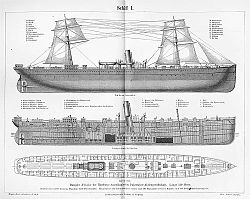Frisia (ship, 1872)
|
Steamship Frisia around 1880/1890
|
||||||||||||||||
|
||||||||||||||||
|
||||||||||||||||
|
||||||||||||||||
|
||||||||||||||||
|
||||||||||||||||
In its time, the Frisia was one of the larger screw ships in the German merchant navy . It was built for HAPAG by Caird & Company in Greenock , began its maiden voyage in 1872 and was scrapped in 1902.
history
She began her maiden voyage on August 21, 1872. In 1885 it was sold to British buyers, and in 1886 it was named Temerario . In 1890 she was renamed again and was now called Arno . In 1898 she was converted into a coal ship. In 1901 it was still used as a Hulk in Genoa , and in 1902 it was broken up in Genoa.
Furnishing
When the Frisia was delivered to the Hamburg-America Line, it was considered to be one of the best and fastest ships in the company. She was 110 meters long and 12.2 meters wide and had four decks. It was powered by machines with 750 hp. The equipment included ten metal lifeboats.
The ship had space for 102 passengers in the first class, 126 in the second and 620 in the third.
The Frisia in Meyer's Lexicon
In its time (around 1880/1890) the Frisia was one of the larger screw ships of the German merchant navy . She was in the service of the Hamburg-American Parcel Shipping Corporation (HAPAG) .
The illustration shows the transatlantic steamer Frisia , in an external view, in a longitudinal section through the plane of symmetry and a horizontal section. From the longitudinal section it can first be seen that the ten boilers become two furnaces , five of which are visible in the port half of the ship. about midway along the length of the ship. In front of and behind the boiler room as well as to the side of it, the storage rooms for the coal are separated by means of iron, watertight walls , which are called coal bunkers and completely enclose the boiler room. The location of the boilers and coal chambers in the middle of the length prevents the center of gravity from shifting due to coal consumption.
Behind the rear transverse coal bunker, the machine room can be seen in the longitudinal section , in which the main parts of the machine developing 3200 hp are shown. The latter is a two-cylinder expansion machine with condensation and a vertical arrangement of the cylinders . To the bearing in the lower part of the engine room crankshaft located in the closing shaft tunnel propeller lying wave at protrudes from the rear end of the ship and immediately before the rowing the propeller carries. In the longitudinal section you can also see the chimney and the fans , which are provided with rotatable heads that are always directed against the wind , which feed the required quantity of air to the boiler fires. The external view shows the lifeboats carried by the ship , which are designed so that they cannot sink; also the rigging . The latter appears only small in relation to the size of the ship, and the sails are arranged relatively far fore and aft. It follows that the pressure of the wind on the sails is only expected to make a small contribution to increasing the speed of the ship, rather the sails are used to give the ship a steady position in relation to the direction of the sea and its swaying Moderate movements around the longitudinal axis . The outer view also shows the round, small side windows for lighting and ventilating the cabins ; these can of course be sealed watertight and are called portholes . The lighter hatching of the lower part of the drawing indicates that this part is the one that is permanently under water; it is painted with red oil paint , the main component of which is red lead , in order to protect the ship's bottom from rusting . The upper part of the ship is painted black in oil.
The decks visible in the longitudinal section divide the inner ship space into four fore and aft rooms, which are partly interrupted in the middle by the engines and boiler rooms. All four longitudinal spaces are divided into sub-compartments by a number of watertight iron transverse walls, which are more numerous in the lower spaces of the ship and towards the ends and therefore smaller than in the middle of the ship and higher up. As far as they are on top of each other, the spaces formed in this way are connected to each other and the upper deck by watertight hatches ; as far as they are next to each other, if necessary, through iron, watertight doors. The purpose of this arrangement is that if the ship leaks , only that compartment can run full of water, in the outer boundary of which the leak is located.
As far as the use of the individual rooms of the ship is concerned, the horizontal section shows the way in which the cabins for the passengers and officers of the ship are arranged along the sides of the ship , while in the middle of the width of the ship there are lounges , dining rooms, etc. are located; the galley is indicated in the vicinity of the chimney ; right at the front are the living quarters of the team . In the second room from above in the foredeck are the beds for the tween deck passengers. The third room from the top and the bottom room are used to store goods.
